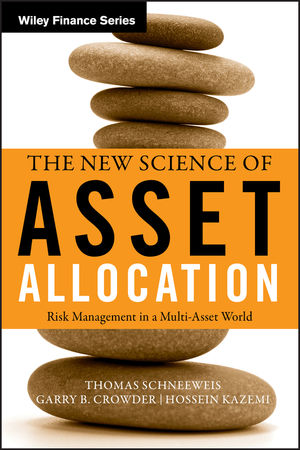The New Science of Asset Allocation: Risk Management in a Multi-Asset WorldISBN: 978-0-470-53740-4
Hardcover
320 pages
March 2010
 This is a Print-on-Demand title. It will be printed specifically to fill your order. Please allow an additional 10-15 days delivery time. The book is not returnable.
|
||||||
Preface xi
Acknowledgments xix
Chapter 1 A Brief History of Asset Allocation 1
In the Beginning 3
A Review of the Capital Asset Pricing Model 4
Asset Pricing in Cash and Derivative Markets 6
Models of Return and Risk Post-1980 11
Asset Allocation in the Modern World 14
Product Development: Yesterday, Today, and Tomorrow 15
Notes 17
Chapter 2 Measuring Risk 20
What is Risk? 22
Traditional Approaches to Risk Measurement 24
Classic Sharpe Ratio 26
Other Measures of Risk Assessment 28
Portfolio Risk Measures 30
Other Measures of Portfolio Risk Measurement 33
Value at Risk 34
Notes 37
Chapter 3 Alpha and Beta, and the Search for a True Measure of Manager Value 39
What is Alpha? 39
Issues in Alpha and Beta Determination 46
Problems in Alpha and Beta Determination 48
Multi-Factor Return Estimation: An Example 50
Tracking Alternatives in Alpha Determination 54
Notes 56
Chapter 4 Asset Classes: What They are and Where to Put Them 58
Overview and Limitations of the Existing Asset Allocation Process 59
Asset Allocation in Traditional and Alternative Investments: A Road Map 61
Historical Return and Risk Attributes and Strategy Allocation 66
Traditional Stock/Bond Allocation versus Multi-Asset Allocation 70
Risk and Return Comparisons Under Differing Historical Time Periods 71
Extreme Market Sensitivity 74
Market Segment or Market Sensitivity: Does It Matter? 82
How New is New? 84
Notes 88
Chapter 5 Strategic, Tactical, and Dynamic Asset Allocation 91
Asset Allocation Optimization Models 92
Strategic Asset Allocation 99
Tactical Asset Allocation 101
Dynamic Asset Allocation 107
Notes 109
Chapter 6 Core and Satellite Investment: Market/Manager Based Alternatives 110
Determining the Appropriate Benchmarks and Groupings 111
Sample Allocations 117
Core Allocation 119
Satellite Investment 120
Algorithmic and Discretionary Aspects of Core/Satellite Exposure 120
Replication Based Indices 122
Peer Group Creation—Style Purity 126
Notes 132
Chapter 7 Sources of Risk and Return in Alternative Investments 134
Asset Class Performance 135
Hedge Funds 139
Managed Futures (Commodity Trading Advisors) 143
Private Equity 148
Real Estate 153
Commodities 160
Notes 166
Chapter 8 Return and Risk Differences among Similar Asset Class Benchmarks 167
Making Sense Out of Traditional Stock and Bond Indices 168
Private Equity 170
Real Estate 173
Alternative REIT Investments Indices 179
Commodity Investment 179
Hedge Funds 185
Investable Manager Based Hedge Fund Indices 185
CTA Investment 189
Index versus Fund Investment: A Hedge Fund Example 189
Notes 194
Chapter 9 Risk Budgeting and Asset Allocation 195
Process of Risk Management: Multi-Factor Approach 195
Process of Risk Management: Volatility Target 200
Risk Decomposition of Portfolio 202
Risk Management Using Futures 203
Risk Management Using Options 206
Covered Call 206
Long Collar 208
Notes 210
Chapter 10 Myths of Asset Allocation 212
Investor Attitudes, Not Economic Information, Drive Asset Values 213
Diversification Across Domestic or International Equity Securities is Sufficient 214
Historical Security and Index Performance Provides a Simple Means to Forecast Future Excess Risk-Adjusted Returns 215
Recent Manager Fund Return Performance Provides the Best Forecast of Future Return 215
Superior Managers or Superior Investment Ideas Do Not Exist 216
Performance Analytics Provide a Complete Means to Determine Better Performing Managers 216
Traditional Assets Reflect “Actual Values” Better Than Alternative Investments 217
Stock and Bond Investment Means Investors Have No Derivatives Exposure 217
Stock and Bond Investment Removes Investor Concerns as to Leverage 218
Given the Efficiency of the Stock and Bond Markets, Managers Provide No Useful Service 218
Investors Can Rely on Academics and Investment Professionals to Provide Current Investment Models and Theories 218
Alternative Assets are Riskier Than Equity and Fixed Income Securities 219
Alternative Assets Such as Hedge Funds are Absolute Return Vehicles 220
Alternative Investments Such as Hedge Funds are Unique in Their Investment Strategies 221
Hedge Funds are Black Box Trading Systems Unintelligible to Investors 222
Hedge Funds are Traders, Not Investment Managers 222
Alternative Investment Strategies are So Unique That They Cannot Be Replicated 223
It Makes Little Difference Which Traditional or Alternative Indices are Used in an Asset Allocation Model 223
Modern Portfolio Theory is Too Simplistic to Deal with Private Equity, Real Estate, and Hedge Funds 223
Notes 225
Chapter 11 The Importance of Discretion in Asset Allocation Decisions 226
The Why and Wherefore of Asset Allocation Models 226
Value of Manager Discretion 230
Manager Evaluation and Review: The Due Diligence Process 232
Madoff: Due Diligence Gone Wrong or Never Conducted 233
Notes 239
Chapter 12 Asset Allocation: Where is It Headed? 240
An Uncertain Future 241
What is the Definition of Order? 243
Costs and Benefits 246
Today’s Issue 246
Possible Governmental and Private Fund Responses to Current Market Concerns 247
Note 249
Appendix: Risk and Return of Asset Classes and Risk Factors Through Business Cycles 251
Glossary: Asset Class Benchmarks 271
Bibliography 279
About the Authors 285
Index 287



